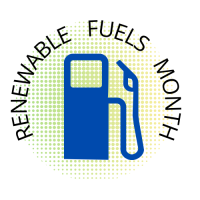FAQs

What is ethanol?
Ethanol is a renewable fuel source made from plants (most commonly corn).
Ethanol burns cleaner than petroleum-based gasoline, which means it releases fewer toxins into the air — making it safer for both the environment and the humans in it.

Does ethanol improve air quality?
Ethanol burns cleaner — emitting fewer toxic emissions into the air.
In fact, the American Lung Association recommends the use of renewable fuels such as ethanol, because the toxins and particulate matter in petroleum-based gasoline poses a threat to human health.
According to a study conducted by the U.S. Department of Agriculture, greenhouse gas emissions (GHG) associated with corn-based ethanol are about 43% lower than gasoline when measured on an energy equivalent basis.

Does using corn to produce ethanol negatively impact our food supply?
No.
The corn used to produce ethanol is not the same corn bred for human consumption. About 99% of corn grown in Nebraska is field corn, which is primarily for livestock feed and ethanol production.
Field corn is rarely used for human food. Through processing it is transformed into fuel, meat, miilk, eggs and food ingredients.

How much water is required to make ethanol?
An ethanol plant uses about three gallons of water to produce one gallon of ethanol — and that water is used with incredible (and increasing) efficiency.
To put that into perspective, about 150 gallons of water go into producing a single newspaper.
Most of the water in an ethanol plant is recycled and reused within the plant for additional production, cooling and other processes. A significant percentage of that water also leaves the plant in the form of distillers grains (livestock feed) and is consumed by animals, supplementing their water requirements.
The remaining water reenters the atmosphere in the form of steam from the boilers and other equipment.

Is ethanol cost-effective? Will it lower my gas mileage?
Many consumers actually report improved gas mileage and engine performance with ethanol blends above E10 — especially E15 and E30.
Because ethanol contains less energy than petroleum-based gasoline, you may see a slight drop in your gas mileage when using a higher blend such as E85; however, the price per gallon advantage of higher ethanol blends typically still outweighs this imbalance.
In other words, it’s not just about miles per gallon. It’s also about cost per mile. Here’s how the math works:
- Assume that using E85 may result in a miles-per-gallon reduction of up to 12%.
- If E85 costs 12% less than E10, you’re miles — and money — ahead.
- So, if E10 costs $2.00 per gallon, E85 would need to cost 24¢ less ($1.76) in order for you to “break even.” And every penny discount above 24¢ reduces your cost per mile even further.
The reality is, E85 blends will almost always be priced at a much greater discount than 12%. If it’s not, you need to find another fuel retailer!

Will ethanol work with my engine?
The short answer: More than likely. Ethanol burns cool and clean — which actually bolsters engine life in vehicles approved to consume it.
E10 is approved for use by every major automaker in the world.
E15 is available at most Nebraska gas stations, and approved for use in all vehicles manufactured after the year 2001.
Higher blends of ethanol, such as E30 or E85 (in Nebraska that means a minimum of 70% ethanol) are approved for use in all flex fuel vehicles (FFV). Not sure if your vehicle falls into that category? Here are some ways to find out:
- Check the owner’s manual.
- Look for a flex fuel badge on your vehicle. Usually it’ll be on the trunk lid, tailgate or rear quarter panel.
- FFVs often have a yellow gas cap or a decal on the inside of the fuel door.
Flex fuel vehicle engines have computers to automatically adjust for the varying percentage of ethanol in whichever fuel you choose. That means that if you drive an FFV, you have the ultimate choice at the pump.

Is the ethanol industry subsidized?
There are no federal or state programs that provide direct payments or subsidies to ethanol producers.
Congress passed the Renewable Fuels Standard (RFS) in 2005 and 2007, requiring a specific volume of transportation fuel in the United States fuel supply to contain renewable fuels such as corn ethanol, biodiesel and ethanol made from cellulosic sources such as cornstalks, switchgrass and wood waste.
The RFS was passed in order to provide market access for domestically produced renewable fuels in a fossil fuel-dominated marketplace, reduce our reliance on imported oil and spur economic development — especially in rural areas of the United States. All of those goals continue to be achieved through the RFS.


